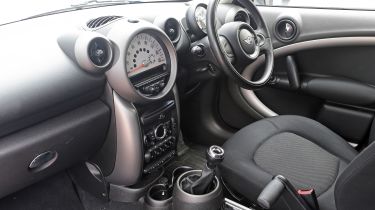Used MINI Countryman (Mk1, 2010-2017) - How practical is it?
While it’s not the most practical small SUV out there, the MINI Countryman Mk1 still offers a decent amount of space
There are more spacious alternatives out there, but the MINI Countryman Mk1 isn’t cramped inside, either. The boot’s a good size, and there’s enough head and leg room for adults to not feel hemmed in. By and large, Countryman Mk1s came as standard with a few creature comforts, although the spec can vary quite drastically between cars, depending on what options were specified when new.
Dimensions and cabin design
When the MINI Countryman Mk1 went on sale, it was by some margin the brand’s largest car to date, measuring in at 4,097mm long, 1,789mm wide and 1,561mm high. However, in keeping with MINI’s more compact roots, the Countryman Mk1 was a bit smaller than some of its rivals – alternatives like the Fiat 500X, Nissan Juke and Peugeot 2008 are quite a bit longer than the Countryman, for instance.
Despite being smaller, the first-gen MINI Countryman is nevertheless a pretty practical car by class standards. Thanks to the car’s boxier dimensions, head and leg room is good all round, and the large door openings make it easy to get into and out of. As standard, the MINI Countryman Mk1 came with five seats, but keep a close eye of the specs on the used listings as a four-seater configuration was available on the Countryman as a no-cost option.
Used - available now

2018 Mini
Countryman
38,272 milesAutomaticPetrol1.5L
Cash £15,200
2020 Mini
Countryman
45,323 milesManualPetrol1.5L
Cash £16,400
2020 Mini
Countryman
31,160 milesAutomaticDiesel2.0L
Cash £15,987
2018 Mini
Countryman
56,378 milesAutomaticDiesel2.0L
Cash £13,100If there’s one area where the MINI Countryman feels a bit on the small side, it’s in the interior storage department. There aren’t many cubby spots in the MINI Countryman Mk1, and the door bins aren’t very big.
Boot space
Complementing the cabin space in the MINI Countryman Mk1 was a pretty spacious boot. At 350 litres, the luggage capacity of the MINI Countryman Mk1 was far better than the 211 litres of boot space in the regular MINI Hatch, and was on par with the boot capacity of some family hatchbacks. However, some of the MINI Countryman’s rivals were roomier still in this department: a contemporary Skoda Yeti has a 416-litre boot, for instance.
The MINI Countryman Mk1’s load area could be increased even further to 1,170 litres, by folding the rear seats down. Do be aware that the seats when folded down don’t lie flush with the boot floor, even on models with the optional adjustable boot floor kit, so there isn’t a completely flat load bay when the MINI Countryman Mk1 is in this configuration.
Equipment and technology
While the MINI Countryman was available with quite a few options extras when it was brand new, the core range came with a pretty respectable amount of equipment across the board. The base-spec One trim level came with the fewest creature comforts, but still had air-conditioning, a digital radio, rear parking sensors, Bluetooth phone connectivity and heated door mirrors. The Cooper trim level was almost identical when it came to standard-fit equipment, with one of the more prominent additions being the 16-inch alloy wheels that replaced the 16-inch steel wheels on the One cars.
Being the sportier models, the Cooper S and Cooper SD versions of the MINI Countryman Mk1 came with more performance car-oriented features such as dynamic traction control and more supportive front seats, on top of cosmetic touches including a redesigned front grille and new 17-inch alloys. The even faster John Cooper Works cars upped the sporty touches even further with a more aggressive bodykit and larger-still 18-inch alloy wheels.
Expect to see a variety of MINI Countryman Mk1 specs on the used listings, because the car was available with an array of optional extras. These varied from cosmetic touches such as stripe decals on the bonnet and a roof spoiler, to more comprehensive changes like automatic headlights, heated front seats and climate control.
Safety
Safety body Euro NCAP assessed in MINI Countryman Mk1 in 2010, and overall had positive things to say about the SUV’s safety credentials. It gave the Countryman Mk1 a five-star rating, and gave it pretty good scores in the adult passenger protection (84 per cent) and child passenger protection (83 per cent) portions of the test. Results in other areas weren’t as impressive, though: the MINI Countryman Mk1 score 71 per cent in the safety assist category, and earned 61 per cent in the pedestrian protection segment.
As standard, the MINI Countryman Mk1 came with a decent amount of safety equipment. All cars came fitted with stability control, central locking, a tyre pressure monitoring system and multiple airbags. The two outer rear seats also had ISOFIX latching points for child seats.








